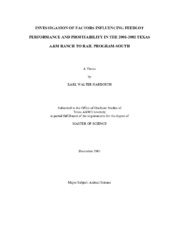| dc.description.abstract | Data from the 2001-2002 Texas A&M University Ranch to Rail Program-South were used to determine factors that influence cattle feedlot performance and profitability. Steers (n=860) were classified according to sire (SBIO) and dam (DBIO) biological groups, kill groups (KILL), and entry month (ENTRYMON). Biological groups were determined by predominant genetic make up of the sire or dam. Traits evaluated included net income (NI), feedlot average daily gain (ADG), slaughter weight (OUTWT), carcass weight (CW), fat thickness (FT), longissimus muscle area (LMA), marbling score (MS), yield grade, (YG), medicine costs (TOTMED), and carcass value (CVL). Analyses of covariance were performed to determine differences between SBIO and DBIO, KILL, and ENTRYMON, and the influence of initial feedlot weight (INWT). Sire biological type had a significant effect on NI, ADG, FT, LMA, MS, YG, and CVL. Dam biological type and KILL had significant effects on all traits excluding TOTMED. Entry month accounted for no differences. Among SBIO groups, British-sired steers exhibited greatest values for ADG (1.39 kg/d), MS (457), FT (1.45 cm), CVL ($891), and NI ($25.62). Continental-sired steers exhibited the largest LMA (97.65 cm) and lowest YG (2.51). Brahman-sired steers exhibited the lowest ADG (1.32kg/d), MS (405), CVL ($859), and NI ($-17.80).
Multiple regression was performed to determine which traits had the greatest effect on CVL and NI. Independent categorical effects were SBIO, DBIO, KILL and ENTRYMON, while independent continuous effects were INWT, ADG, FT, LMA, MS and TOTMED. Both CVL and NI were influenced by CW, FT, LMA, and MS, but not by ADG, INWT, or TOTMED.
Phenotypic correlation coefficients were determined among all traits. Highest correlations were present between CVL: and NI, CW, ADG, and LMA (0.80, 0.81, 0.54, and 0.49, respectively). Strong correlations were seen between ADG and CW (0.63), FT and YG (0.87) and YG and LMA (-0.51). Marbling score was moderately correlated to CVL (0.30) and NI (0.30). This study indicates that a wide variety of traits interact to determine CVL and NI in retained ownership programs, and that maximizing carcass value does not ensure increased profitability. | en |


